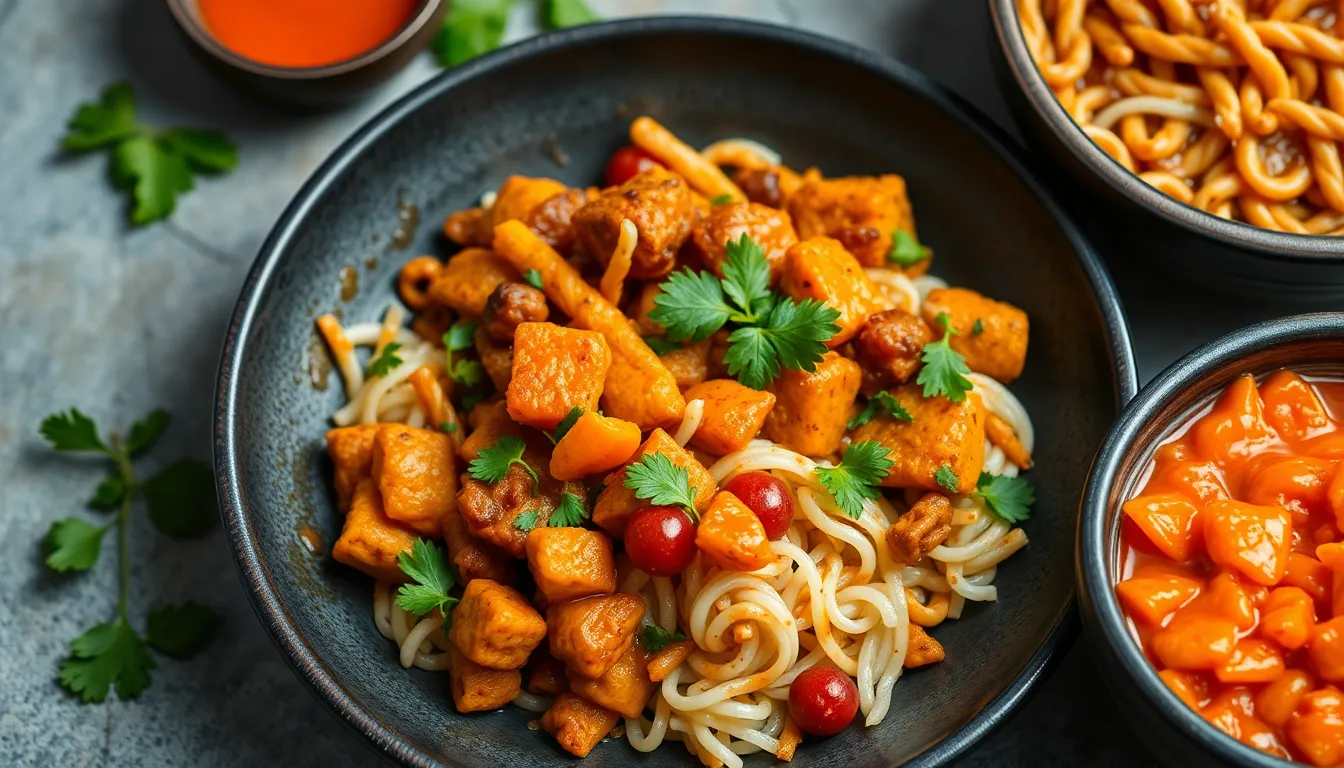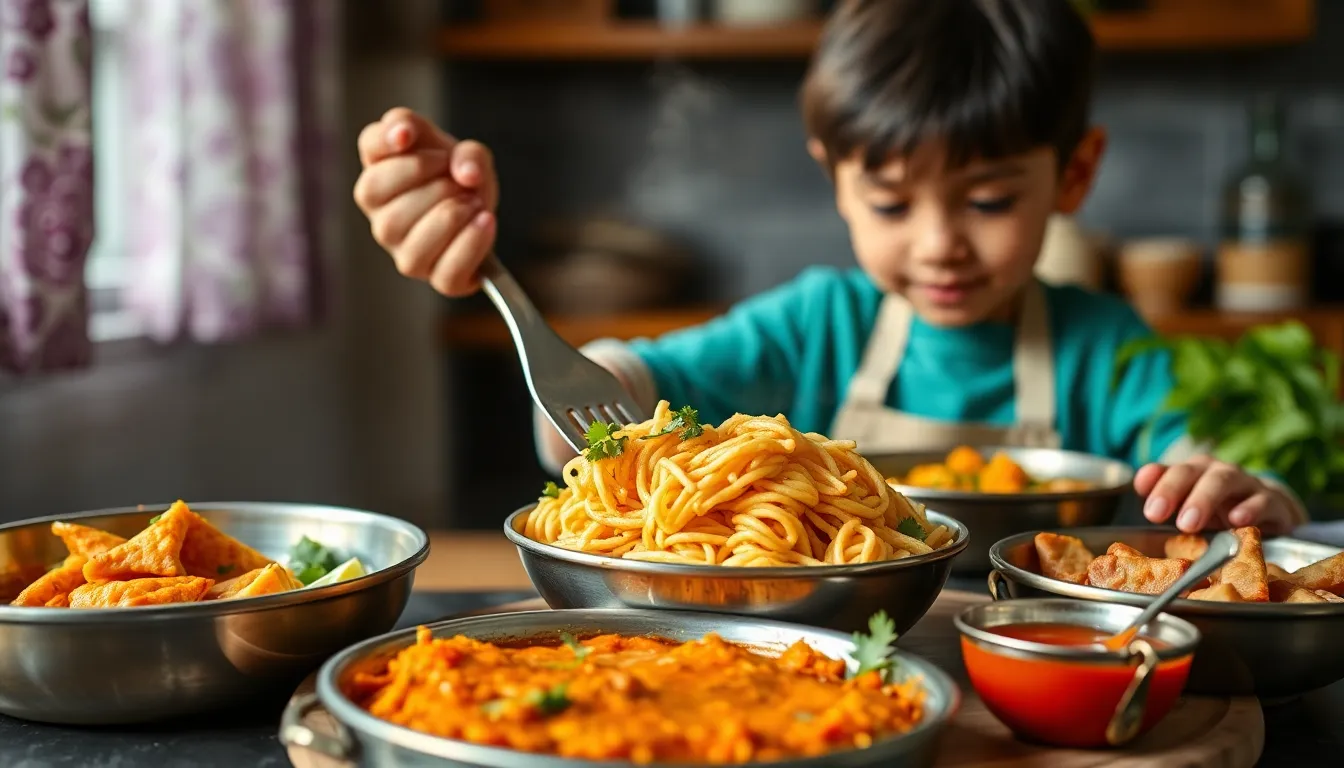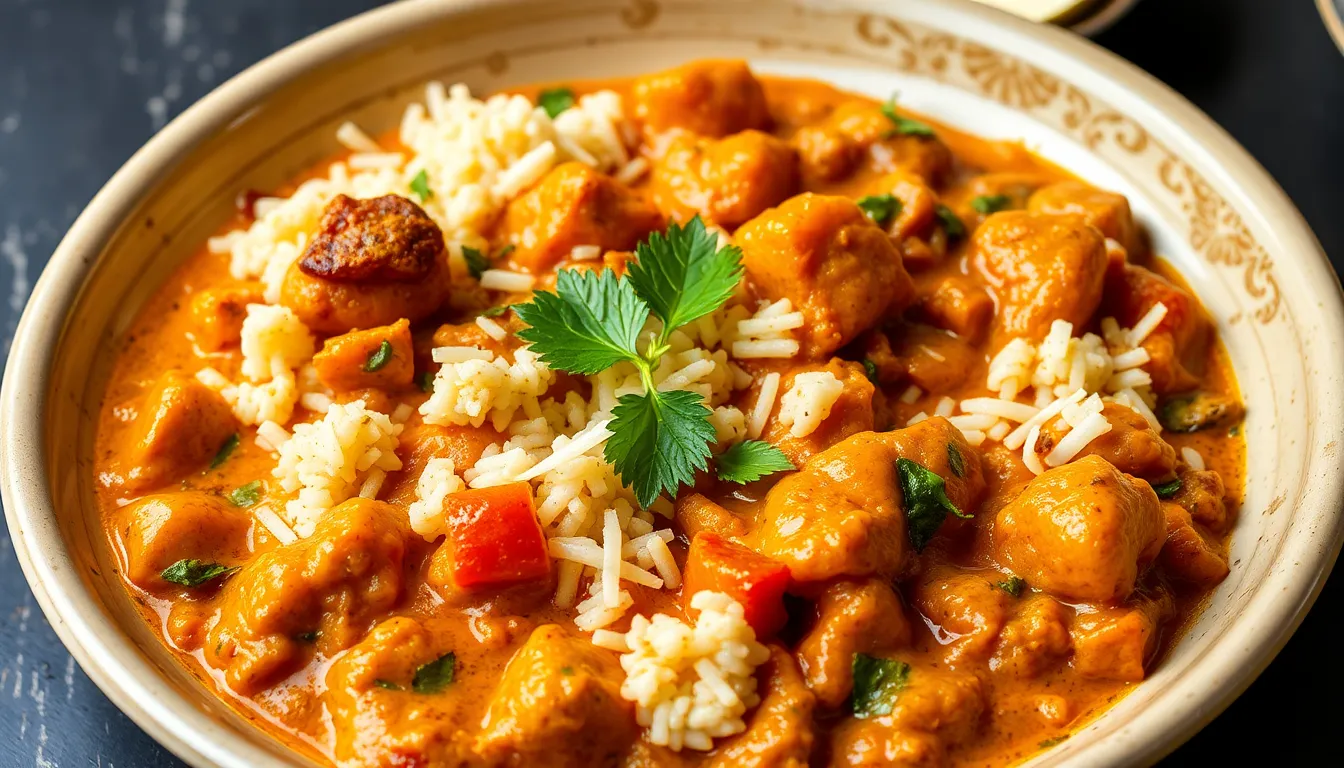The Vegan Indian Kitchen: Plant-Based Recipes Bursting with Flavor
Welcome to a culinary adventure that takes you deep into the vibrant world of Indian cuisine, enriched by the principles of veganism. As one of the most diverse and celebrated culinary traditions, Indian food offers a multitude of flavors, textures, and aromas, all of which can be adapted to a delightful plant-based lifestyle. In this post, we will explore the essential ingredients of a vegan Indian kitchen, delicious recipes that showcase these flavors, and tips on how to bring it all together for an unforgettable dining experience.
Introduction: A Journey into the Heart of Vegan Indian Cuisine
Indian cuisine is a tapestry woven from the diverse cultures, traditions, and landscapes of the subcontinent. Each region boasts its own specialties, from the spicy curries of the South to the rich gravies of the North. As the global awareness of health and environmental issues rises, veganism has gained considerable popularity, encouraging many to explore plant-based diets.
Adopting a vegan lifestyle not only helps in reducing one’s carbon footprint but also offers several health benefits, including lower risks of chronic diseases, improved digestion, and enhanced energy levels. Whether you are a longtime vegan or simply looking to incorporate more plant-based meals into your diet, the richness of Indian cuisine provides an abundance of options that are both satisfying and nourishing.
Section 1: Essential Ingredients in the Vegan Indian Pantry
1.1 The Spice Symphony: Essential Spices to Stock
No Indian kitchen is complete without a well-stocked spice rack. Spices are the heart of Indian cooking, and they not only enhance flavor but also offer numerous health benefits. Here are some essential spices to include:
- Cumin: Aids digestion and adds a warm, earthy flavor.
- Coriander: Fresh and citrusy, it’s great for balancing flavors.
- Turmeric: Known for its anti-inflammatory properties, it imparts a golden hue.
- Garam Masala: A blend of spices that adds warmth and complexity to dishes.
| Spice | Flavor Profile | Common Uses | Health Benefits |
|---|---|---|---|
| Cumin | Warm, earthy | Curries, dals, rice dishes | Aids digestion, rich in antioxidants |
| Coriander | Fresh, citrusy | Salsas, curries, chutneys | Anti-inflammatory, aids digestion |
| Turmeric | Warm, slightly bitter | Curry blends, rice, soups | Anti-inflammatory, antioxidant |
| Garam Masala | Warm, sweet, spicy | Curries, marinades, soups | Boosts immunity, improves digestion |
1.2 Pulses and Legumes: The Protein Powerhouses
When it comes to plant-based protein, pulses and legumes reign supreme. Rich in fiber, vitamins, and minerals, they are essential for any vegan diet. Here are some common legumes used in Indian cooking:
- Chickpeas: Versatile and can be used in curries, salads, and snacks.
- Lentils: Available in various colors (red, green, brown), they cook quickly and are perfect for soups and dals.
- Kidney Beans: Great for hearty dishes like rajma and chili.
When cooking pulses, soaking them beforehand can dramatically reduce cooking time and improve digestibility. Always rinse them well before use.
1.3 Fresh Produce: Seasonal Vegetables to Elevate Your Dishes
Fresh produce is vital in vegan Indian cooking, adding color, texture, and nutrients to meals. Here are some seasonal vegetables that are staples in Indian cuisine:
- Eggplants: Used in dishes like baingan bharta, they absorb flavors beautifully.
- Okra: Crisp and tender, perfect for stir-fries and curries.
- Spinach: A nutritious green that can be used in saag dishes or salads.
To find the freshest produce, consider shopping at local farmers’ markets or organic grocers where seasonal vegetables are more readily available.
Section 2: Flavorful Vegan Indian Recipes
2.1 Starters that Spark Joy: Appetizers to Impress
Recipe 1: Vegan Samosas with Mint Chutney
These crispy pastries filled with spiced potatoes and peas are perfect for any gathering.
Ingredients:
- 2 cups all-purpose flour
- 4 medium potatoes, boiled and mashed
- 1 cup green peas
- 1 tsp cumin seeds
- 2 green chilies, finely chopped
- Salt to taste
- Oil for frying
Instructions:
- Mix flour, salt, and a tablespoon of oil in a bowl. Gradually add water to form a dough. Cover and let it rest.
- In a pan, heat oil and add cumin seeds. Once they splutter, add chilies, mashed potatoes, and peas. Season with salt, cook for a few minutes, and let cool.
- Divide the dough into small balls and roll each ball into a thin circle. Cut in half and form a cone, filling it with the potato mixture. Seal the edge with water.
- Deep fry until golden brown. Serve with mint chutney.
Recipe 2: Spicy Chickpea Tikki
These delightful patties are crisp on the outside and soft on the inside.
Ingredients:
- 1 cup canned chickpeas, drained
- 1 small onion, finely chopped
- 1 tsp garam masala
- 1 tsp red chili powder
- Fresh coriander, chopped
- Salt to taste
- Oil for frying
Instructions:
- In a bowl, mash chickpeas until coarse. Mix in onions, spices, and coriander.
- Form into small patties and refrigerate for 30 minutes.
- Heat oil in a pan and fry until golden on both sides.
- Serve with chutney or yogurt.
Tips for presentation: Serve your samosas and tikki on a colorful platter with fresh herbs for a visually appealing touch.
2.2 Soulful Curries: Heartwarming Main Dishes
Recipe 1: Creamy Coconut Vegetable Curry
This rich and creamy curry is a delightful way to enjoy a medley of vegetables.
Ingredients:
- 1 can coconut milk
- 2 cups mixed vegetables (carrots, bell peppers, cauliflower)
- 1 onion, chopped
- 2 cloves garlic, minced
- 1 tsp turmeric
- 1 tsp coriander powder
- Salt and pepper to taste
- Fresh cilantro for garnish
Instructions:
- Heat a pan, add onions, and sauté until translucent. Add garlic and sauté for another minute.
- Add mixed vegetables, turmeric, coriander, salt, and pepper. Cook until vegetables are tender.
- Pour in coconut milk and simmer for 10 minutes.
- Garnish with cilantro before serving.
Recipe 2: Tofu Tikka Masala
A vegan twist on a classic favorite, this tofu tikka masala is bursting with flavor.
Ingredients:
- 1 block firm tofu, pressed and cubed
- 1 cup yogurt (plant-based)
- 2 tbsp tikka masala spice blend
- 1 onion, chopped
- 1 can diced tomatoes
- Salt to taste
Instructions:
- Marinate tofu cubes in yogurt and tikka masala for at least 1 hour.
- In a pan, add onions and sauté until golden. Add marinated tofu and cook for 5 minutes.
- Add diced tomatoes and simmer for 15 minutes. Adjust seasoning before serving.
Variations for added flair: Try adding spinach or bell peppers to the coconut curry for a vibrant twist, or serve the tofu tikka with grilled vegetables.
2.3 Sides that Steal the Show: Accompaniments to Your Meal
Recipe 1: Fluffy Vegan Naan
This soft and pillowy naan is perfect for scooping up curries.
Ingredients:
- 3 cups all-purpose flour
- 1 tsp sugar
- 1 tsp baking powder
- 1 cup warm water
- 2 tbsp olive oil
Instructions:
- Mix flour, sugar, and baking powder. Gradually add water and oil to form a soft dough.
- Let the dough rest for 1 hour. Divide into balls and roll out into circles.
- Cook on a hot skillet until bubbles form, then flip to cook the other side.
Recipe 2: Quinoa Pulao with Peas and Carrots
This light and fragrant quinoa pulao is a perfect complement to rich curries.
Ingredients:
- 1 cup quinoa
- 1 cup peas
- 1 carrot, diced
- 1 onion, chopped
- 2 cups vegetable broth
- Spices: cumin, bay leaf, salt
Instructions:
- Rinse quinoa under cold water. In a pot, sauté onions until golden.
- Add spices, peas, and carrots, then quinoa. Pour in broth and bring to a boil.
- Reduce heat, cover, and simmer for 15 minutes or until quinoa is fluffy.
Pairing suggestions: Serve naan with the coconut curry and quinoa pulao on the side for a complete meal experience.
2.4 Sweet Endings: Decadent Vegan Desserts
Recipe 1: Coconut Ladoo
These sweet coconut balls are a festive treat, perfect for special occasions.
Ingredients:
- 2 cups grated coconut
- 1 cup condensed coconut milk
- 1 tsp cardamom powder
Instructions:
- Mix grated coconut, condensed milk, and cardamom in a pan over low heat.
- Stir continuously until the mixture thickens. Let it cool slightly.
- Form into small balls and roll in extra coconut if desired.
Recipe 2: Vegan Gulab Jamun
This classic Indian dessert has a vegan twist, using plant-based ingredients.
Ingredients:
- 1 cup all-purpose flour
- 1/4 cup almond milk
- 1/2 tsp baking powder
- 1 cup sugar
- 1 cup water
- Cardamom and rose water for flavor
Instructions:
- Combine flour, baking powder, and almond milk to form a dough. Shape into small balls.
- Fry balls in hot oil until golden. In another pot, boil sugar and water to make syrup.
- Add cardamom and rose water to the syrup. Soak fried balls in the syrup for a few hours.
Ingredient substitutions: Use coconut cream instead of almond milk for a richer texture in gulab jamun.
Section 3: Bringing It All Together: Meal Planning and Preparation
3.1 Batch Cooking: Saving Time Without Sacrificing Flavor
Batch cooking is a great way to save time and ensure you always have delicious vegan Indian meals on hand. Here are strategies to make the most out of your meal prep:
- Choose simple recipes that can be easily doubled or tripled.
- Cook large batches of grains like rice or quinoa and store them in the refrigerator.
- Prepare sauces and curries in advance, as they often taste better the next day.
Suggested meal combinations for the week: Pair creamy coconut vegetable curry with quinoa or serve vegan samosas with a side of spicy chickpea tikki.
3.2 Hosting a Vegan Indian Feast: Tips for Entertaining
Planning a themed dinner party is an exciting way to showcase the magic of vegan Indian cuisine. Here’s how to host a successful feast:
- Choose a variety of dishes to cater to different tastes and preferences.
- Set the ambiance with Indian music and decorative elements like colorful tablecloths and candles.
- Consider serving traditional beverages such as chai tea or refreshing masala lemonade.
Conclusion: The Endless Possibilities of Vegan Indian Cooking
As we conclude this flavorful journey, it’s clear that vegan Indian cuisine offers endless possibilities for creativity and experimentation. The versatility of plant-based ingredients allows you to create dishes that are not only rich in flavor but also wholesome and nourishing. I encourage you to explore, innovate, and make these recipes your own. Remember, every meal is an opportunity to express your love for food and share it with others.
Call to Action: Join the Vegan Indian Kitchen Community
If you enjoyed this exploration of vegan Indian cooking, I invite you to subscribe to our blog for more delicious recipes and cooking tips. Share your experiences, favorite dishes, or any recipe requests in the comments below. Let’s embark on this flavorful journey together!




